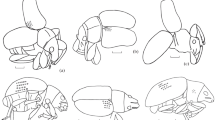Abstract
A new circumscriptional name Tetrastigmoptera taxon n. is suggested for the extinct taxon comprising the Cretaceous species Mydiognathus eviohlhoffae Yoshizawa et Lienhard, 2016 (= Psocorrhyncha burmitica Huang et al., 2016) and Burmopsylla maculata Liang et al., 2016, described based on well-preserved specimens from Burmese amber, and also some Triassic and Permian species known by less completely preserved specimens. This taxon is known under the typified names Permopsocida and Archipsyllidae. The systematic position of Tetrastigmoptera remains unclear. The formerly expressed opinions about this taxon belonging to Acercaria and about its relationship with Copeognatha and/or Condylognatha are erroneous, caused by wrong notion about the structure of recent insects. The structure and assumed function of the mouth apparatus of Copeognatha, which basically differs from that of Tetrastigmoptera and other chewing insects, is discussed. The phylogenetic significance of such characters as bimotority, presence of tibial spurs, number of tarsomeres, presence of cerci, and some others is discussed. It is demonstrated yet again that the parsimony principle and the taxon/character matrices are totally inconsistent with phylogenetic analysis.
Similar content being viewed by others
References
Enderlein, G., “Zur Kenntnis frühjurassischer Copeognathen und Coniopterygiden und über das Schicksal der Archipsylliden,” Zoologischer Anzeiger 34, 770–776(1909).
Engel, M.S. and Grimaldi, D.A., “The First Mesozoic Zoraptera,” American Museum Novitates 3362, 1–20(2002).
Haliday, A.H., “An Epitome of the British Genera in the Order Thysanoptera,” Entomological Magazine 3, 439–451(1836).
Handlirsch, A., Die fossilen Insecten und die Phylogenie der rezenten Formen(Leipzig, 1906-1908).
Handlirsch, A., “Geschichte, Literatur, Technik, Paläontologie, Phylogenie, Systematik,” in Schröder, Ch., Handbuch der Entomologie. Vol. 3(Verlag von Gustav Fischer, Jena, 1925), pp. 1–1201.
Hennig, W., Insect Phylogeny. Translated and Edited by A.C. Pont, Revisionary Notes by D. Schlee (J. Wiley & Sons, Chichester etc., 1981).
Huang, D.-Y., Bechly, G., Nel, P., Engel, M.S., Prokop, J., Azar, D., Cai, Ch.-Y., van de Kamp, Th., Staniczek, A.H., Garrouste, R., Krogmann, L., Rolo, T.S., Baumbach, T., Ohlhoff, R., Shmakov, A.S., Bourgoin, Th., and Nel, A., “New Fossil Insect Order Permopsocida Elucidates Major Radiation and Evolution of Suction Feeding in Hemimetabolous Insects (Hexapoda: Acercaria),” Scientific Reports 6(23004), 1–9(2016).
Kluge, N.J., “A System of Alternative Nomenclatures of Supra-Species Taxa. Linnaean and Post-Linnaean Principles of Systematics,” Entomologicheskoe Obozrenie 78(1), 224–243(1999) [Entomological Review 79(2), 133–147 (1999)].
Kluge, N.J., Modern Systematics of Insects(Lan, St. Petersburg, 2000) [in Russian].
Kluge, N.J., “About Evolution and Homology of Genital Appendages of Insects,” Trudy Russkogo Entomologicheskogo Obshchestva 74, 3–16(2003).
Kluge, N.J., The Phylogenetic System of Ephemeroptera(Kluwer Academic Publishers, 2004).
Kluge, N.J., “Circumscriptional Names of Higher Taxa in Hexapoda,” Bionomina 1, 15–55(2010).
Kluge, N.J., “General System of Neoptera with Description of a New Species of Embioptera,” Russian Entomological Journal 21(4), 371–384(2012).
Kluge, N.J., Insect Systematics and the Principles of Cladoendesis(KMK Scientific Press, Moscow), in print.
Liang, F., Zhang, W.W., and Liu, X., “A New Genus and Species of the Paraneopteran Family Archipsyllidae in Mid-Cretaceous Amber of Myanmar,” Zootaxa 4105(5), 483–490(2016).
Manton, S.M., “Mandibular Mechanisms and the Evolution of Arthropods,” Philosophical Transactions of the Royal Society of London B 247(737), 1–183(1964).
Martynov, A.V., “Jurassic Fossil Insect from Turkestan. 6. Homoptera and Psocoptera,” Izvestiya Akademii Nauk SSSR 20(13-14), 1349–1366(1926).
Nel, P., Azar, D., and Nec, A., “A New ‘Primitive’ Family of Thrips from Early Cretaceous Lebanese Amber (Insecta, Thysanoptera),” Cretaceous Research 28, 1033–1038(2007).
Nel, P., Azar, D., Prokop, J., Roques, P., Hodebert, G., and Nel, A., “From Carboniferous to Recent: Wing Venation Enlightens Evolution of Thysanopteran Lineage,” Journal of Systematic Palaeontology 10(2), 385–399(2012).
Nel, P., Retana- Salazar, A.P., Azar, D., Nel, A., and Huang, D.-Y., “Redefining the Thripida (Insecta: Paraneoptera),” Journal of Systematic Palaeontology 12(7), 865–878(2014).
Otanes, F.Q., “Head and Mouth-Parts of Mecoptera,” Annals of the Entomological Society of America 15(4), 310–323(1922).
Rasnitsyn, A.P., “The Historical Development of the Class Insecta,” Trudy Paleontologicheskogo Instituta Akademii Nauk SSSR 175, 1–269(1980).
Rohdendorf, B.B., “On Rationalization of Names of High-Rank Taxa in Zoology,” Paleontologicheskii Zhurnal 2, 14–22(1977).
Tillyard, R.J., The Biology of Dragonflies (Odonata or Paraneuroptera)(Cambridge University Press, Cambridge, 1917).
Tillyard, R.J., “The Panorpoid Complex,” Proceedings of the Linnean Society of New South Wales 43(170), 265–319(1918); 43(171), 626–657 (1918); 44(175), 533–718 (1919).
Tillyard, R.J., “Kansas Permian Insects. Part 8. The Order Copeognatha,” American Journal of Sciences 11, 315–349(1926).
Vishniakova, V.N., “The New Palaeozoic and Mesozoic Lophioneuridae (Thripida),” Trudy Paleontologicheskogo Instituta Akademii Nauk SSSR 183, 43–63(1981).
Yoshizawa, K., “Phylogeny and Higher Classification of Suborder Psocomorpha (Insecta: Psocodea: ‘Psocoptera’),” Zoological Journal of the Linnean Society 136, 371–400(2002).
Yoshizawa, K., “Morphology of Psocomorpha (Psocodea: ‘Psocoptera’),” Insecta Matsumurana (N.S.) 62, 1–44(2005).
Yoshizawa, K. and Lienhard, Ch., “Bridging the Gap between Chewing and Sucking in the Hemipteroid Insects: New Insights from Cretaceous Amber,” Zootaxa 4079(2), 229–245(2016).
Zherikhin, V.V., “A New Genus and Species of Lophioneuridae from Burmese Amber (Thripida (= Thysanoptera): Lophioneurina),” Bulletin of the Natural History Museum (Geology) 56(1), 39–41(2000).
Author information
Authors and Affiliations
Corresponding author
Rights and permissions
About this article
Cite this article
Kluge, N.J. Cladoendesis of Parametabola and Systematic Position of the Extinct Taxon Tetrastigmoptera taxon nov.. Entmol. Rev. 99, 362–383 (2019). https://doi.org/10.1134/S0013873819030084
Received:
Revised:
Accepted:
Published:
Issue Date:
DOI: https://doi.org/10.1134/S0013873819030084




